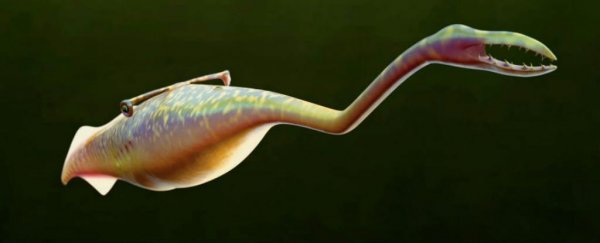Nobody really knows what a Tully monster is. It's maybe a squid thing. Or like a lamprey. Only it has these weird eye stalks, and a… is that a tentacle or a claw? It's a mouth? Seriously?
Categorising the 300 million year old fossilised remains of Tullimonstrum gregarium was never going to be easy. Just look at it. A recent analysis of eye pigments in animals is doing nothing to settle the argument, either.
A few years ago, researchers analysing the structures and chemical signatures of the Tully monster's eyes concluded its pigments had more in common with those of fish, than of snails or squid.
Researchers from University College Cork in Ireland and Fujita Health University in Japan have now analysed pigments in the eyes of modern cephalopods and several fish species to determine just how much we can rely on chemical signatures of screening pigments to distinguish major categories of the animal kingdom.
The short answer is we can't. Whatever we thought Tully monster was, it isn't now.
Though there might be a handy catch.
The rock that started all of this was dug up by an amateur fossil hunter named Francis Tully back in 1955. The fossil within that rock was weird, to say the least. There were no clear bony parts, and it had stiff eye stalks jutting out from the sides, as well as a kinked snout ending in a claw.
For half a century palaeontologists have wondered where the animal might fit in the tree of life. Usually that discussion is a question of species, or occasionally genus or family. For T. gregarium, nobody has been able to confirm whether an invertebrate or not, leaving its entire phylum up for discussion.
In 2016, researchers from Yale University came down hard on the vertebrate side, claiming a pale gut-like structure in Tully monster fossils was actually a notochord, or primitive backbone.
Then came the eye study, which identified the presence of tiny pigment bodies of melanin called melanosomes that absorb stray light rays, keeping them from interfering with the animal's vision.
Invertebrates, like squid, were thought to rely on other chemicals, such as an ommochrome or pterin, for screening pigments, so this all but confirmed the Tully monster was more fish-like than squid-like.
But not everybody was convinced, with some thinking a more holistic approach couldn't rule out an invertebrate classification.
"Eyes have evolved dozens of times. It's not too much of a leap to imagine Tully monsters could have evolved an eye that resembled a vertebrate eye," University of Pennsylvania palaeobiologist Lauren Sallen said back in 2017.
Squid and octopuses have an incredibly complex visual system, and also produce melanin in other parts of their body. So it wouldn't be all that surprising to discover melanosomes inside their eyes as well.
Nobody had looked closely though - until now. The researchers examined screening pigments from the common octopus (Octopus vulgaris), European squid (Loligo vulgaris), and common cuttlefish (Sepia officianalis), and found at least some invertebrates can have melanin bodies in their eyes after all.
It seems Sallen had a solid point. Tully can have melanosomes like a vertebrate but still be a squid-like-thing. So, back to square one we go - although we do have some new clues, too.
The team also found the kinds of melanosomes that cephalopods have bind trace metals differently to vertebrates. So, they took a close look at a Tully monster-fossil, finding its melanosomes contain lower amounts of zinc compared to eyes in vertebrate fossils from the same area.
They also found a significant amount of copper ions, also hinting that the creature has more in common with cuttlefish than it does with lampreys.
This doesn't make Tully a squid any more than a notochord would have made it a fish. It might make any argument in favour of its taxonomy as a backboned animal a little less likely, though.
Just don't expect this discovery to settle the debate once and for all. Whatever this Jim Henson muppet happens to be, it's going to take a few more investigations like this one before we can close the book on it for good.
This research is published in the Proceedings of the Royal Society B.
